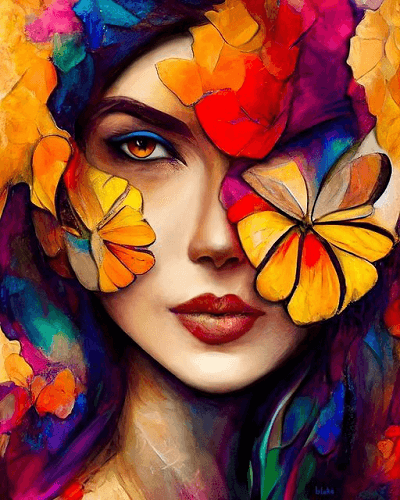Recognizing the Importance Behind Remarkable Trump Art Creations
Recognizing the Importance Behind Remarkable Trump Art Creations
Blog Article
Starting an Aesthetic Trip With the Lyrical Analyses of Nature in Impressionist Landscapes
Each brushstroke, each play of light and darkness, and each color selection in their jobs talks volumes about the musicians' deep link to nature and their capability to convert its elegance onto the canvas. As we explore the lyrical interpretations of nature in Stylist landscapes, we are welcomed to submerse ourselves in a world where truth and emotion link, supplying a peek into the artists' extensive appreciation for the all-natural globe.
The Captivating Brushstrokes of Claude Monet
Claude Monet's proficiency of brushstrokes transcends plain technique, imbuing his landscapes with an aerial top quality that fascinates and mesmerizes viewers - trump art. His cutting-edge use color and light, integrated with his unique brushwork, creates a sense of activity and life within his paints. Monet's popular series of works illustrating water lilies and his famous haystacks display his capability to record the short lived results of light and atmosphere

Embracing Light and Shadow With Camille Pissarro
Personifying a similar reverence for the interplay of light and shadow, Camille Pissarro's creative vision unravels as a harmonious exploration of the all-natural globe's luminescent nuances. Pissarro, a crucial number in the Impressionist movement, masterfully caught the vibrant partnership between light and shadow in his landscapes. His skilled use color and brushwork enabled him to share the refined shifts in light that specify various times of day and periods.
Pissarro's paints commonly include spotted sunlight filtering through leaves, casting complex patterns of light and darkness on the planet listed below. In jobs such as "Hoar Frost, the Effect of Snow, Pontoise," Pissarro skillfully depicts the crisp brightness of winter sunlight juxtaposed with the great darkness that specify the snowy landscape. By embracing both light and darkness in his make-ups, Pissarro welcomes viewers to immerse themselves in the natural charm and transient impacts of light worldwide around them.

Through Pissarro's works, we are reminded of the transformative power of light and shadow, inviting us to stop and value the short lived minutes of elegance existing in the daily landscapes that border us.
A Harmony of Color Styles by Edgar Degas
Edgar Degas coordinates a vivid harmony of shades in his skillful art work, instilling his compositions with a vibrant interaction of shades that captivate the visitor's stare. Recognized largely for his ballet professional dancers and intimate scenes of Parisian life, Degas adeptly adjusted colors to convey state of mind and motion in his paintings. trump art. His use of vibrant, different shades and subtle tonal variations created a sense of deepness and vibrancy within his works
Degas' shade combination usually contained rich blues, deep greens, and cozy oranges, which he applied with confident brushstrokes to record the significance of his subjects. Whether representing a ballerina mid-performance or a team of good friends conversing at a coffee shop, Degas' shades not only showed the scene however also stimulated a sense of feeling and energy.
In Our site Addition, Degas' trial and error with light and shadow included an extra layer of intricacy to his color compositions, boosting the overall ambience of his paintings (trump art). Through his proficient control of color, Degas produced an aesthetic official statement symphony that proceeds to reverberate with customers today
Exploring Nature's Peacefulness With Berthe Morisot
Berthe Morisot's imaginative vision offers a tranquil departure from the lively shade symphonies of Edgar Degas, as she records the serenity of nature in her expressive landscapes. Known for her fragile brushwork and intimate representations of everyday life, Morisot's landscapes show a sense of tranquility and consistency.
Morisot's paintings usually feature soft, soft tones that share a sense of calmness and serenity. Her works, such as "The Cradle" and "Summer season's Day," showcase her capability to record the subtle charm of nature in a means that is both soothing and contemplative to the customer.
Unlike several of her Impressionist counterparts that concentrated on bold colors and dynamic make-ups, Morisot preferred to create gentle, reflective scenes that welcome the visitor to mirror and stop. With her skillful use light and shadow, Morisot develops a sense of harmony that resonates with the audience on a deep emotional degree.
The Psychological Landscapes of Vincent Van Gogh
Vincent Van Gogh's landscapes clearly convey a deepness of feeling through their dynamic brushwork and expressive use of color. The Dutch post-impressionist artist is renowned for his capability to catch extreme and raw feelings in his paints, going beyond typical depictions of nature. Van Gogh's tumultuous personal life, noted by psychological wellness struggles, greatly influenced his art, infusing his landscapes with a sense of worry, moody, or liveliness.
In works such as "Starry Evening" and "Wheatfield with Crows," Van Gogh's swirling brushstrokes and vivid shade selections stimulate an extensive psychological action from customers. The unstable skies and upset landscapes in his paintings reflect his internal chaos and psychological disturbance, inviting viewers to dig into the intricacies of his subconscious.
Van Gogh's special visual language, characterized by overstated viewpoints and strong use shade, produces landscapes that resonate with viewers on a deeply psychological level. Via his art, Van Gogh invites us to see nature not simply as an outside truth but as a mirror of our innermost sensations and feelings.
Conclusion
Finally, the impressionist landscapes of musicians such as Claude Monet, Camille Pissarro, Edgar Degas, Berthe Morisot, and Vincent Van Gogh provide a unique and exciting visual analysis of nature. Through their use read more of brushstrokes, light, shade, and feeling, these musicians have actually produced a symphony of pictures that stimulate a sense of calmness and elegance in the natural globe. Their works proceed to inspire and bewitch viewers with their lyrical analyses of the landscapes around us.
Each brushstroke, each play of light and shadow, and each color selection in their works speaks quantities concerning the artists' deep link to nature and their ability to translate its beauty onto the canvas. His ingenious usage of shade and light, combined with his unique brushwork, develops a sense of movement and life within his paintings. His experienced usage of color and brushwork enabled him to share the refined shifts in light that define various times of day and periods.

Report this page